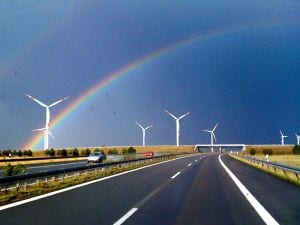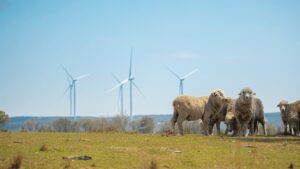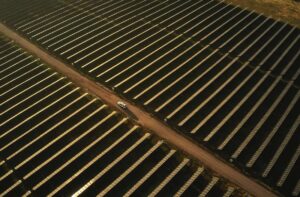The main claim used to justify nuclear is that it’s the only low carbon power source that can supply ‘reliable, base load electricity. But not only can renewables supply baseload power, they can do something far more valuable: supply power flexibly according to demand. That makes nuclear power really redundant.
“In the words of former Green Senator Christine Milne, ‘We are now in the midst of a fight between the past and the future.’ The refutation of the baseload fairy tale and other myths falsely denigrating renewable energy are a key part of that struggle.”

We have all heard the claim. We need nuclear power because, along with big hydropower, it’s the only low carbon generation technology that can supply ‘reliable baseload power’ on a large scale.
For example, the UK Energy Secretary Amber Rudd, attempted to justify the decision to build the proposed Hinkley Point C nuclear power station on the grounds that “we have to secure baseload electricity.”
Similarly, former Australian Industry Minister Ian Macfarlane recently claimed at a uranium industry conference: “Baseload, zero emission, the only way it can be produced is by hydro and nuclear.”
Underlying this claim are three key assumptions. First, that baseload power is actually a good and necessary thing. In fact, what it really means is too much power when you don’t want it, and not enough when you do. What we need is flexible power (and flexible demand too) so that supply and demand can be matched instant by instant.
The second assumption is that nuclear power is a reliable baseload supplier. In fact it’s no such thing. All nuclear power stations are subject to tripping out for safety reasons or technical faults. That means that a 3.2GW nuclear power station has to be matched by 3.2GW of expensive ‘spinning reserve’ that can be called in at a moments notice.
The third is that the only way to supply baseload power is from baseload power stations, such as nuclear, coal and gas, designed to run flat-out all the time whether their power is actually needed or not. That’s wrong too.
Practical experience and computer simulations show it can be done
But first, take a look at Figure 1, which shows the daily variation of electricity demand in summer in a conventional large-scale electricity grid without much solar energy. Baseload demand is the pale blue region across the bottom of the graph.

‘Baseload power stations’ are inflexible in operation, in the sense that they are unsuitable for following the variations in demand and supply on timescales of minutes and hours, so they have to be supplemented with flexible peak-load and slightly flexible intermediate-load power stations.
Peak-load power stations are hydro-electric systems with dams and open-cycle gas turbines (OCGTs), essentially jet engines set up for power generation rather than aircraft propulsion. They can respond to variations in demand and supply on timescales of minutes.
The assumption that baseload power stations are necessary to provide a reliable supply of grid electricity has been disproven by both practical experience in electricity grids with high contributions from renewable energy, and by hourly computer simulations.
In 2014 the state of South Australia had 39% of annual electricity consumption from renewable energy (33% wind + 6% solar) and, as a result, the state’s base-load coal-fired power stations are being shut down as redundant. For several periods the whole state system has operated reliably on a combination of renewables and gas with only small imports from the neighbouring state of Victoria.
The north German states of Mecklenburg-Vorpommern and Schleswig-Holstein are already operating on 100% net renewable energy, mostly wind. The ‘net’ indicates trading with each other and their neighbours. They do not rely on baseload power stations.
A host of studies agree: baseload power stations are not needed
“That’s cheating”, nuclear proponents may reply. “They are relying on power imported by transmission lines from baseload power stations elsewhere.” Well, actually the imports from baseload power stations are small.
For countries that are completely isolated (e.g. Australia) or almost isolated (e.g. the USA) from their neighbours, hourly computer simulations of the operation of the electricity supply-demand system, based on commercially available renewable energy sources scaled up to 80-100% annual contributions, confirm the practical experience.
In the USA a major computer simulation by a large team of scientists and engineers found that 80-90% renewable electricity is technically feasible and reliable (They didn’t examine 100%.) The 2012 report, Renewable Electricity Futures Study. Vol.1. Technical report TP-6A20-A52409-1 was published by the US National Renewable Energy Laboratory (NREL). The simulation balances supply and demand each hour.
The report finds that “renewable electricity generation from technologies that are commercially available today, in combination with a more flexible electric system, is more than adequate to supply 80% of total U.S. electricity generation in 2050 while meeting electricity demand on an hourly basis in every region of the United States.”
Similar results have been obtained from hourly simulation modeling of the Australian National Electricity Market with 100% renewable energy (published by Ben Elliston, Iain MacGill and I in 2013 and 2014) based on commercially available technologies and real data on electricity demand, wind and solar energy. There are no baseload power stations in the Australian model and only a relatively small amount of storage. Recent simulations, which have yet to be published, span eight years of hourly data.
These, together with studies from Europe, find that baseload power stations are unnecessary to meet standard reliability criteria for the whole supply-demand system, such as loss-of-load probability or annual energy shortfall.
Furthermore, they find that reliability can be maintained even when variable renewable energy sources, wind and solar PV, provide major contributions to annual electricity generation, up to 70% in Australia. How is this possible?
Fluctuations balanced by flexible power stations
First, the fluctuations in variable wind and solar PV are balanced by flexible renewable energy sources that are dispatchable, i.e. can supply power on demand. These are hydro with dams, Open Cycle Gas Turbines (OCGTs) and concentrated solar thermal power (CST) with thermal storage, as illustrated in Figure 2. It ‘s not essential for every power station in the system to be dispatchable.

Incidentally the gas turbines can themselves be fuelled by ‘green gas’, for example from composting municipal and agricultural wastes, or produced from surpluses of renewable electricity. More on this below …
Second, drawing on diverse renewable energy sources, with different statistical properties, provides reliability. This means relying on multiple technologies and spreading out wind and solar PV farms geographically to reduce fluctuations in their total output. This further reduces the already small contribution from gas turbines to just a few percent of annual electricity generation.
Third, new transmission lines may be needed to achieve wide geographic distribution of renewable energy sources, and to multiply the diversity of renewable energy sources feeding into the grid. For example, an important proposed link is between the high wind regions in north Germany and the low wind, limited solar regions in south Germany. Texas, with its huge wind resource, needs greater connectivity with its neighbouring US states.
Fourth, introducing ‘smart demand management’ to shave the peaks in electricity demand and to manage periods of low electricity supply, can further increase reliability. This can be assisted with smart meters and switches controlled by both electricity suppliers and consumers, and programmed by consumers to switch off certain circuits (e.g. air conditioning, water heating, aluminium smelting) for short periods when demand on the grid is high and/or supply is low.
As summarized by the NREL study: “RE (Renewable Energy) Futures finds that increased electricity system flexibility, needed to enable electricity supply-demand balance with high levels of renewable generation, can come from a portfolio of supply- and demand-side options, including flexible conventional generation, grid storage, new transmission, more responsive loads, and changes in power system operations.”
A recent study by Mark Jacobson and colleagues went well beyond the above studies. It showed that all energy use in the USA, including transport and heat, could be supplied by renewable electricity. The computer simulation used synthetic data on electricity demand, wind and sunshine taken every 30 seconds over a period of six years.
Storage or ‘windgas’ could also manage fluctuations
The above ‘flexible’ approach may not be economically optimal for the UK and other countries with excellent wind resource but limited solar resource. Another solution to managing fluctuations in wind and solar is more storage, e.g. as batteries or pumped hydro or compressed air.
A further alternative is the ‘windgas’ scenario recently advocated by Energy Brainpool as a greener and lower cost alternative to the UK’s Hinkley C nuclear project. The idea is to use excess wind energy to produce hydrogen gas by electrolysing water and then convert the hydrogen to methane that fuels combined cycle gas turbine (CCGT) power stations.
In fact, not all the hydrogen needs to be converted into methane, and it’s more efficient to keep some of it as hydrogen, a useful fuel in its own right. Another option is to use the hydrogen to make ammonia (NH3) which can both be used as a fuel, and as a feedstock for the fertiliser industry, displacing coal or natural gas.
In Brainpool’s scenario, the system is used to replicate the power output of the 3.2GW Hinkley C nuclear power station, and shows it can be done at a lower cost. But in fact, it gets much better than that:
- as each wind turbine, CCGT, gas storage unit and ‘power to gas’ facility is completed, its contribution begins immediately, with no need for the whole system to be built out;
- the system would in practice be used to provide, not baseload power, but flexible power to meet actual demand, and so would be much more valuable;
- as solar power gets cheaper, it will integrate with the system and further increase resilience and reduce cost;
- the whole system creates grid stability and cannot drop out all at once like a nuclear plant, producing negative ‘integration costs’.
But in all the flexible, renewables-based approaches set out above, conventional baseload power stations are unnecessary. In the words of former Australian Greens’ Senator Christine Milne: “We are now in the midst of a fight between the past and the future”.
The refutation of the baseload fairy tale and other myths falsely denigrating renewable energy are a key part of that struggle.
This article was first published in Ecologist. Reproduced with permission.








